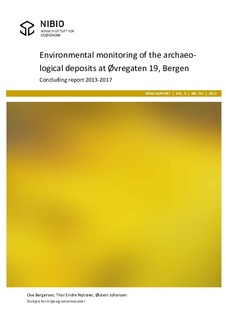Environmental monitoring of the archaeological deposits at Øvregaten 19, Bergen. Concluding report 2013-2017
Research report
Published version
Permanent lenke
http://hdl.handle.net/11250/2459783Utgivelsesdato
2017-10-12Metadata
Vis full innførselSamlinger
Sammendrag
This concluding report contains all the monitoring data collected in the course of five years, from Jan. 2013 to Aug. 2017 from the protected archaeological deposits at Øvregaten 19, Bergen. The deposits had high contents of organic material and high water content before monitoring started. Data showed minimum temperatures close to 0-2°C under winter conditions and Maximum temperatures at 14°C during the first year of monitoring 2013. In 2014 the minimum temperature increased to 6-7°C and the maximum temperature increased to 17-18°C. Data recorded in 2015 showed minimum temperature 7-9°C and maximum temperature at 16-19°C. The average and median values calculated in the last two years 2016 & 2017 were increased to 22°C in the upper part of the pit and stable at 14°C in the deeper layers. This high temperature in the upper part of the pit, which is higher than mean ambient air temperature, may be due to the new house and the flagstones placed over and close to the pit where the monitoring equipment was installed.High soil moisture was found in all layers, and fluctuated with precipitation. This increased more frequently in 2014 and 2015 under periods with high precipitation. This high precipitation frequency and the infiltration of roof water has decreased the redox potential to more anoxic conditions, which is positive for the preservation of the archaeological remains.
